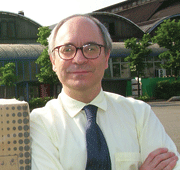E-Archive
Standards Forum
in Vol. 12 - September Issue - Year 2011
A Precise Knowledge of Peening Shot

Giovanni Gregorat

Paul Huyton
I was recently contacted by an MFN reader and asked "What are the main differences between two specifications for peening shot; SAE J827 and SAE AMS 2431/1?" Both of these specifications are used to specify new cast steel shot for peening applications with the latter, SAE AMS2431/1 being one of eight types of peening shot defined by AMS2431.
At MFN we have a team of specialists and trainers who all have a broad knowledge of peening. Of course, each individual does have an extra depth of knowledge in a particular aspect of the process. My MFN colleague Giovanni Gregorat is a specialist in peening shot and so I requested that he answer this question. Although the enquirer received an individual reply from Giovanni, I wanted to share some of this information with our wider readership.
SAE J827
- This specification describes the chemical composition and some of the physical characteristics of high carbon cast steel shot to be used for blast-cleaning and some shot peening applications.
- It does not give shot size distribution limits, for which reference must be made to SAE J444.
- Concerning shot peening applications, this specification is referred to for so-called "industrial" shot peening applications. These include shot peening of springs, suspension and steering systems, gears, drill bits, earthmoving equipment components, etc. But for "aerospace" shot peening applications reference must be made to the "AMS" family of SAE specifications, which includes AMS 2431/1. Note that some high performance, non-aerospace applications, such as auto-sport gears, use the AMS specification to maximize the quality of their peening process.
- SAE J827 gives a hardness range of 40 - 51 HRC.
SAE AMS 2431/1
- AMS stands for "Aerospace Material Specification" and this specification describes the chemical composition and the physical characteristics of high carbon cast steel shot to be used for "aerospace" shot peening applications.
- Shot production and quality control parameters according to AMS specifications are stricter compared to the "J" family of SAE specifications.
- AMS2431/1 is used in conjunction with other AMS specifications in order to ensure a high degree of quality control for the shot.
-This high quality provides the maximum benefit from the peening process and the highest degree of repeatability for the peening process.
- This specification gives a hardness range of 45 - 52 HRC, while its companion specification, AMS 2431/2, gives a hardness range of 55 - 62 HRC.
Both J827 and AMS2431/1 are specifications for shot at the time of supply to the end user. The specifications can be used to periodically verify the delivered product as such verification is typically a requirement in Quality Assurance Standards. The Nadcap AC7117 revision A checklist requires a periodic verification of shot size and shape before the shot is released for production use.
J827 and AMS2431/1 are used to specify the shot which is to be loaded into a peening machine and are quite comprehensive in their requirements. The quality of the recycled shot within the peening machine is normally determined using the peening process specification, for example AMS2430.The recycled shot quality requirement does not need to be comprehensive and is typically a size check using one or two sieves and an inspection for unacceptable shapes such as "teardrop" and broken particles. In cases where the process specification does not give requirements for size and shape, many users will use the "new shot" requirements in J827 or AMS2431for the size and shape check.
Maintaining good shot quality is paramount in achieving the desired outcome from the peeing process. The required resistance to fatigue and stress corrosion cracking may not be achieved unless adequate shot quality is maintained.
The MFN team welcomes such technical enquiries and we will always endeavour to provide an objective, accurate answer to these questions. If enquiries are directed to me, I will answer them myself or direct them to the most appropriate MFN team member.
If a problem requires greater research or development, then MFN can provide a consultancy service which will deliver results to a mutually defined brief and at a mutually agreed cost. And, of course, MFN training courses provide knowledge and skills which enable clients to determine their own solutions and process improvements. Training courses are available for Shot Peening, Flap Peening, Vibro-Finishing, Residual Stresses and their Measurement, Painting and International Business.
For questions contact paul@mfn.li
Standards Forum
by Paul Huyton,
MFN Course Director World Wide
more information at www.mfn.li/trainers



























